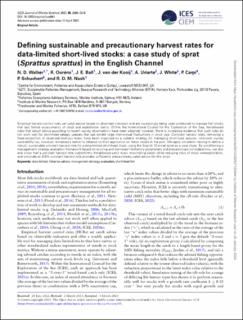| dc.contributor.author | Walker, N.D. | |
| dc.contributor.author | Ouréns, R. | |
| dc.contributor.author | Ball, J.E. | |
| dc.contributor.author | Van Der Kooij, Der | |
| dc.contributor.author | Uriarte, A. | |
| dc.contributor.author | White, J. | |
| dc.contributor.author | Carpi, Piera | |
| dc.contributor.author | Schuchert, P. | |
| dc.contributor.author | Nash, Richard David Marriott | |
| dc.date.accessioned | 2024-01-26T09:34:31Z | |
| dc.date.available | 2024-01-26T09:34:31Z | |
| dc.date.created | 2024-01-19T13:04:59Z | |
| dc.date.issued | 2023 | |
| dc.identifier.citation | ICES Journal of Marine Science. 2023, 80 (10), 2606-2618. | |
| dc.identifier.issn | 1054-3139 | |
| dc.identifier.uri | https://hdl.handle.net/11250/3114039 | |
| dc.description.abstract | Empirical harvest control rules set catch advice based on observed indicators and are increasingly being used worldwide to manage fish stocks that lack formal assessments of stock and exploitation status. Within the International Council for the Exploration of the Sea, trend-based rules that adjust advice according to recent survey observations have been adopted; however, there is increasing evidence that such rules do not work well for short-lived pelagic species that can exhibit large inter-annual fluctuations in stock size. Constant harvest rates, removing a fixed proportion of observed biomass index, have been proposed as a suitable strategy for managing short-lived species. Unknown survey catchability has, however, remained a barrier to reliance on their application on these stocks in the past. We apply simulation testing to define a robust, sustainable constant harvest rate for a data-limited short-lived stock, using the English Channel sprat as a case study. By conditioning a management strategy evaluation framework based on existing and borrowed life-history parameters and precautionary considerations, we test and show that a constant harvest rate outperforms trend-based catch rules, maximizing yields while reducing risks of stock overexploitation, and conclude an 8.6% constant harvest rate provides sufficiently precautionary catch advice for this stock. | |
| dc.language.iso | eng | |
| dc.title | Defining sustainable and precautionary harvest rates for data-limited short-lived stocks: a case study of sprat (Sprattus sprattus) in the English Channel | |
| dc.title.alternative | Defining sustainable and precautionary harvest rates for data-limited short-lived stocks: a case study of sprat (Sprattus sprattus) in the English Channel | |
| dc.type | Peer reviewed | |
| dc.type | Journal article | |
| dc.description.version | publishedVersion | |
| dc.source.pagenumber | 2606-2618 | |
| dc.source.volume | 80 | |
| dc.source.journal | ICES Journal of Marine Science | |
| dc.source.issue | 10 | |
| dc.identifier.doi | 10.1093/icesjms/fsad061 | |
| dc.identifier.cristin | 2230377 | |
| cristin.ispublished | true | |
| cristin.fulltext | original | |
| cristin.qualitycode | 2 | |
